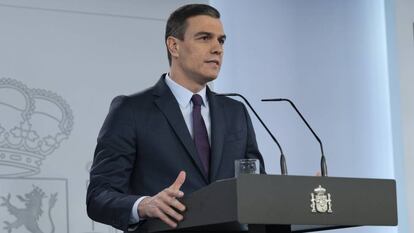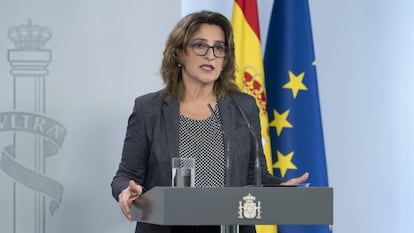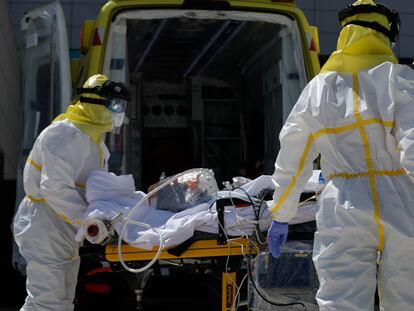Spanish government will avoid setting dates for deescalation measures
The “Plan for the Transition toward a new normality” will instead set out phases and the changes that each step involves. PM Sánchez is due to present the details at a press conference

Spain has opted for a different deescalation process of its coronavirus confinement measures compared to European partners such as France and Italy. The program, which has been officially dubbed the “Plan for the Transition Toward a New Normality,” will not have precise dates for the reopening of businesses, beaches or bars, as will happen in other countries, according to government sources. The executive, which has been retouching the plan right up until the last minute today during a long Cabinet meeting – which was delayed due to the final text arriving late – has opted for a different formula, based on four phases: 0, 1, 2 and 3.
The text sets out what can be opened during each one of these phases and the changes that each step involves, but not the actual dates of when these measures will be introduced. The document establishes a series of markers to move from one phase to the other, but these decisions will be taken in a manner that is coordinated between the government and the regions, and will be revised every two weeks.
After children were allowed out for hourly walks from last weekend, the next step will be a similar relaxation for adults from this weekend onward. But from that point on the next steps will be much more complicated.
The text focuses in particular on tourism, one of the sectors that most concerns the government because it has ground to a complete halt and accounts for more than 12% of Spain’s GDP.
But there is no concrete date in the plan for the reopening of beaches or hotels, but there are details of the phases that will have to be evaluated in each province according to the situation of the pandemic.
Prime Minister Pedro Sánchez is due to present this plan in detail at a press conference. Within the executive, they believe that this formula of phases is a much better approach than that of other countries, where dates are being set out despite the risk of them having to be corrected in the future.
Preparations
In order to prepare for the deescalation, the executive consulted with a panel of around 50 experts in health and epidemiology, as well as advisors on social, economic and international issues.
Government officials have also sought advice from dozens of individuals including regional and local political leaders, academics, members of medical associations, union representatives, industry leaders from the retail, tourism and energy sectors, and non-profit groups.
The stated goal is to ensure the country’s regional healthcare systems can cope with the effects of the coronavirus over the coming months, even as the lockdown is gradually loosened so that both society and the economy can transition to “the new normal,” in the words of Teresa Ribera, one of Spain’s four deputy prime ministers and the minister for ecological transition.

Spain introduced a strict lockdown on March 14, keeping all residents in confinement except for essential business such as trips to supermarkets and pharmacies. The country has experienced some of the highest coronavirus death and contagion levels in the world, with the official number of fatalities at 23,822 as of Tuesday, although the real number could be much higher due to lack of early diagnostic testing. Daily deaths have been dropping in recent days, with 301 recorded on Tuesday, down from the peak of 950 in early April.
It was only on Sunday that children were allowed out on supervised walks for an hour a day, and if contagion levels keep dropping, the general population will be granted some time for daily exercise starting this weekend. With activity nearly at a standstill for six weeks, the economy and the labor market have also taken a significant hit. The unemployment rate is 14.4% and the International Monetary Fund is forecasting an economic contraction of around 8% due to the coronavirus crisis.
English version by Susana Urra and Simon Hunter.
Tu suscripción se está usando en otro dispositivo
¿Quieres añadir otro usuario a tu suscripción?
Si continúas leyendo en este dispositivo, no se podrá leer en el otro.
FlechaTu suscripción se está usando en otro dispositivo y solo puedes acceder a EL PAÍS desde un dispositivo a la vez.
Si quieres compartir tu cuenta, cambia tu suscripción a la modalidad Premium, así podrás añadir otro usuario. Cada uno accederá con su propia cuenta de email, lo que os permitirá personalizar vuestra experiencia en EL PAÍS.
¿Tienes una suscripción de empresa? Accede aquí para contratar más cuentas.
En el caso de no saber quién está usando tu cuenta, te recomendamos cambiar tu contraseña aquí.
Si decides continuar compartiendo tu cuenta, este mensaje se mostrará en tu dispositivo y en el de la otra persona que está usando tu cuenta de forma indefinida, afectando a tu experiencia de lectura. Puedes consultar aquí los términos y condiciones de la suscripción digital.
More information
Últimas noticias
Most viewed
- Why we lost the habit of sleeping in two segments and how that changed our sense of time
- Charles Dubouloz, mountaineering star, retires at 36 with a farewell tour inspired by Walter Bonatti
- Venezuela faces its most tense Christmas yet
- CBS in crisis after pulling a report on Trump’s deportations to El Salvador (which later leaked online)
- Bukele clan fumes over investigation exposing their new wealth









































